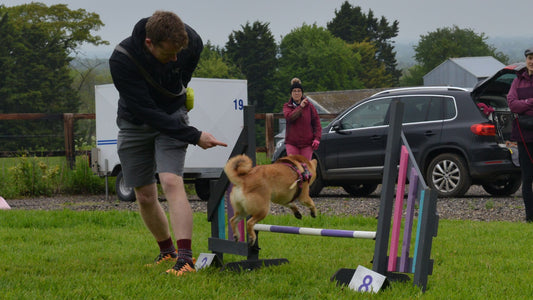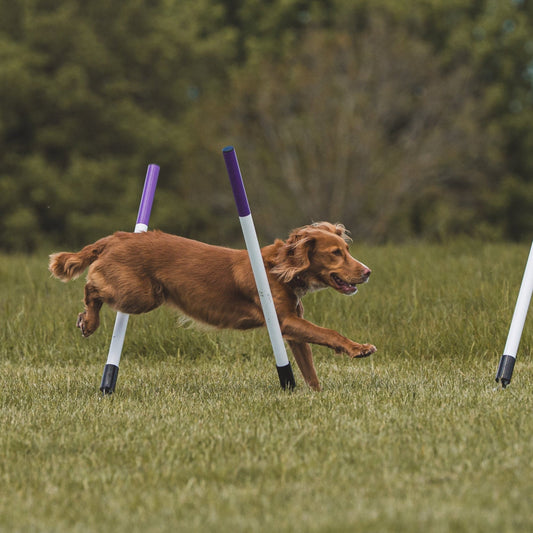What we do in the third week of the beginner’s course
Taking part in weeks 1 & 2’s lesson plans, you will have run in one direction, this week you run short courses and taught some more advanced handling moves called ‘crosses’ to change your dog’s direction, from clockwise to anticlockwise for example.
Front Cross
A front cross is a handling move where you get ahead of your dog and turn, plus change your driving arm* so that the dog changes which side they are to you. *Here’s a link to week 2’s guide in case you need a refresher on this <<Week 2>>
This gives us the ability to move in a clockwise and anticlockwise direction on an agility course.
How week 2’s session works:
You will be taught the ‘front cross’ manoeuvre and a ‘blind cross’ in which you change the handling side of your dog to navigate turns which you can watch me and my own crazy cocker* do here:
To watch Emma & Thea do 'crosses' CLICK HERE
*See her crazy side in the GIF below 🤪

Crosses look and feel great when they’ve been practised to the point that they flow, but while learning the footwork, can feel a bit tricky. This is where practice makes perfect!
In class, I will show you some simple figures of 8 drills that practice the new skill using a combination of posts and then jumps.
Finally, we will put it into practice on a jump sequence that may include a tunnel, where we will start with easy turns and progress to sharper ‘crosses’.
You will lead using one arm, get ahead of your dog and turn and swap to use your other arm so the dog switches which side they are.
Preparation: Prior to this, it will have been important to practice with the dogs on your left and right, so they are comfortable on both sides. Alongside the fan work guides from <<Week 2>> another good way to do this is have them on both sides. I find the easiest way to do this naturally is to always walk my dog on the inside, away from the traffic and as I cross a road, pop them on the other side.
How to practice dog agility at home:
You can practice the front cross handling moving using toys or bowls instead of jumps.
This practice teaches the dog to follow your drive arm to find an obstacle on the course when we put it into sequences as the dogs' progress.
You can work with a training partner or alone if your dog has a reliable wait.
If you want a bit of support for your start line sit-stays check out our free place board training.
- Imagine a clock face
- Position your dog at six o'clock in a wait or use a helper to restrain
- Place the reward (for example a food bowl with a treat or toy) in the imaginary two o'clock position.
- Return to your dog and reward them for staying steady as the reward was placed.
- With your dog on your left, walk out on their right side, with your left arm out acting as the driving arm.
- Stand in the middle of your imaginary circle, with your feet facing 12 o’clock but twist your torso to look back at, and connect with your dog.
- Say “OK” to release your dog.
- When the dog is released, turn to your left to face them on their way to you and swap to point with your right arm to send your dog to the reward at two o'clock.
Repeat the exercise by mirroring the steps above and walking out on your dog’s right side instead. Place the reward in different positions, for example, at three o'clock or nine o'clock.
Goal to achieve: Practice until you feel comfortable and fluid with the handling movement and your dog changes from one side to another and is directed onto the laid reward each time.
Please share your questions and progress:
We would love to see how you get on with your dog’s introduction to front crosses. For tips from me and to share success post your pictures and videos in the Anglian Dog Works Facebook group. https://www.facebook.com/angliandogworks
About the author:
Hi 👋 I’m Emma, accredited as a professional dog trainer by the Institute of Modern Dog Trainers (IMDT). I help owners of energetic dogs achieve the dog-owning life they envisioned by providing robust obedience & agility training for dogs in Balsham and Barton, near Cambridge.
Disclaimer: The content of this article does not include personalised advice and is for information purposes only. If you need individual advice or other enquiries please click here to get in contact or if you're not local to Anglian Dog Works, you can find a trainer in your area by going to the IMDT website: https://www.imdt.uk.com/find-a-qualified-imdt-trainer


